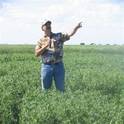
Sheep (Ovis aries L.) grazing, an effective method of controlling weeds and pests in a wheat (Triticum aestivum L.)–fallow system, may affect dryland soil properties and wheat yield. We evaluated the effects of fallow management for weed control and soil water conservation (sheep grazing, herbicide application [chemical], and tillage [mechanical]) and cropping sequence (continuous spring wheat [CSW], spring wheat–fallow [SW-F], and winter wheat–fallow [WW-F]) on soil nutrients and chemical properties in the 0- to 60-cm depth and wheat yield. The experiment was conducted in a Blackmore silt loam from 2004 to 2008 in southwestern Montana. Soil P and K concentrations at 0 to 30 cm were lower in the grazing than in the chemical or mechanical treatments. In contrast, soil Na, Ca, and Mg concentrations were greater in the grazing and mechanical than the chemical treatment. Soil Mg concentration at 30 to 60 cm was greater under CSW than WW-F. Soil SO4–S concentration varied with fallow management and cropping sequence. Soil pH, cation exchange capacity (CEC), and electrical conductivity (EC) at 0 to 15 cm were greater in the mechanical than in the chemical or grazing treatments. Annualized wheat yield was greater under CSW than SW-F or WW-F but was not affected by fallow management. Sheep grazing affected soil nutrients probably by consuming wheat residues but returning them at various levels through feces and urine. In contrast, tillage increased pH, CEC, and EC, probably by incorporating crop residue, feces, and urine into the soil. By applying enough P and K fertilizers to wheat and using less intensive grazing, sheep grazing can be used to sustain wheat yields without seriously affecting soil nutrients and chemical properties.
Available at: http://works.bepress.com/andrew_lenssen/7/
